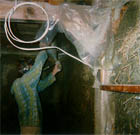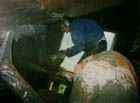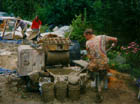|
Frank Andresen and the Strawbale Revolution
by John Tarleton
PENOBSCOT, Maine — Three 5-gallon buckets of clay. Three buckets of sand. A bucket of chopped straw and a gallon of water, all poured into a morter mixer. A two-story, post-and-beam house that has been painstakingly erected on a stone foundation and which is now fresh with the barnyard smell of 300 strawbales held in place by chicken wire.
Surviving in the Shade of the Strawbale Movement
"I can survive in the shade of the strawbale movement," he says. On an overcast weekend in late August, he patiently instructed the house's owner builders and a constantly changing team of 6-10 volunteers in the techniques of his work. While people swarmed around him, he alternately directed traffic and manned the spray gun, splattering 10,000 pounds of clay-plaster on the walls over a four-day period. And, the walls of straw took on a solid form. The ephemeral attained permenence. A dream was transformed into a home. "It's fabulous! It should last for centuries," said Bill Melendy of Little Tree Farm in Penobscot. He and his wife Tamara McElroy had been working sporadically for the past 2 1/2 years on their house. They contacted Andresen in July after hearing accounts of Andresen's talent for using updated versions of traditional clay-building techniques.
Frank Andresen's Odyssey
"I looked around me and saw nothing," Frank recalled. "I asked myself: Where are all the people living in clay?" Intrigued, Frank, his girlfriend at the time, and his best friend launched their own company. "We were digging with a shovel in one hand and holding a book in the other," he said. Clay is the result of the slow effloresence of feldspar, quartz and mica and it is found in most regions of the world. It was used 10,000 years ago to form the walls in post-and-beam buildings that were the first permenent structures built by humans when they settled down to become agriculturalists. Clay serves as a heat absorber and regulates indoor temperature variations. Mixed with fibers like straw, it provides excellent insulation. The clay preserves and protects the fibers from insects, mice, fire and absorbs odors while lending itself to architectural creativity and flexibility. And unlike many present-day building products, it has a proven record of success and durability. Andresen's business grew steadily over the years. But as it did, he found himself being drawn away from the original, activist impulse that drew him to work with simple, non-toxic building materials. Over half of his work was on the preservation of medieval buildings that date back to the 14th Century. The rest was on buildings for middle and upper-class people. "Gradually, you start working for people with money to pay," Andresen noted. "Then for people who have barred windows and drive around in bullet-proof cars."
An American Nomad
"I was innocent of heart. I trusted things would work out. So, I got it all." Within three weeks, he found himself with a simple house, car, steady girlfriend and plenty of work. He has quickly become an American Nomad, tossing all his tools in the back of his '88 Mazda pickup to travel to worksites up and down the East Coast and give workshops as far away as Arizona. What the U.S. lacks in good bread and good beer, it at least partially makes up for with its boundless opportunities. "The thing with community and neighbors here is very different. If it weren't for people from the community coming over to help, I wouldn't be able to do what I am doing," Andresen said. "Here in Maine you can buy some land for $5,000. And for another $5,000, you can make yourself a house. In Germany, the young people are not even thinking about this." Able at last to fuse craftsmanship with social activism, Andresen finds a deep contentment in his work. And he looks forward to continuing into the future. "It's important to me to be doing work that feels right to me," he said. He then pointed at his right wrist. "I don't want to be doing it for one of these, a gold watch you know, when I turn 65."
Strawbale Links
Back to On the Road with John Tarleton
|



